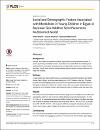Social and Demographic Factors Associated with Morbidities in Young Children in Egypt: A Bayesian Geo-Additive Semi-Parametric Multinomial Model
Abstract
Background
Globally, the burden of mortality in children, especially in poor developing countries, is alarming and has precipitated concern and calls for concerted efforts in combating such health problems. Examples of diseases that contribute to this burden of mortality include diarrhea, cough, fever, and the overlap between these illnesses, causing childhood morbidity and mortality.
Methods
To gain insight into these health issues, we employed the 2008 Demographic and Health Survey Data of Egypt, which recorded details from 10,872 children under five. This data focused on the demographic and socio-economic characteristics of household members. We applied a Bayesian multinomial model to assess the area-specific spatial effects and risk factors of co-morbidity of fever, diarrhea and cough for children under the age of five.
Results
The results showed that children under 20 months of age were more likely to have the three diseases (OR: 6.8; 95% CI: 4.6–10.2) than children between 20 and 40 months (OR: 2.14; 95% CI: 1.38–3.3). In multivariate Bayesian geo-additive models, the children of mothers who were over 20 years of age were more likely to have only cough (OR: 1.2; 95% CI: 0.9–1.5) and only fever (OR: 1.2; 95% CI: 0.91–1.51) compared with their counterparts. Spatial results showed that the North-eastern region of Egypt has a higher incidence than most of other regions.
Conclusions
This study showed geographic patterns of Egyptian governorates in the combined prevalence of morbidity among Egyptian children. It is obvious that the Nile Delta, Upper Egypt, and south-eastern Egypt have high rates of diseases and are more affected. Therefore, more attention is needed in these areas.
Collections
- Mathematics, Statistics & Physics [805 items ]


